Content
Published:
This is an archived release.
Continued weak figures in manufacturing
Norwegian industrial managers report a further downturn in the total output in the first quarter of 2016. The continued weak trend among manufacturers of capital goods drives the downturn. The general expectations for the next quarter are negative among the majority of the industrial leaders.
| 1st quarter 2016 | ||
|---|---|---|
| Changes from previous quarter | Expected changes in next quarter | |
| 1A diffusion index is compiled using the estimated percentages on "ups" and "same" according to the formula: (ups + 0,5 * same). The diffusion index has a turning point at 50. An index value above 50 indicates growth in the variable, and opposite for a value below 50. | ||
| Total volume of production | 48.0 | 45.3 |
| Average capacity utilisation | 48.6 | 48.0 |
| Average employment | 41.3 | 39.3 |
| New orders received from home markets | 45.8 | 46.5 |
| New orders received from export markets | 42.8 | 45.6 |
| Total stock of orders | 42.3 | 44.5 |
| Prices on products at home markets | 49.1 | 49.9 |
| Prices on products at export markets | 47.6 | 47.0 |
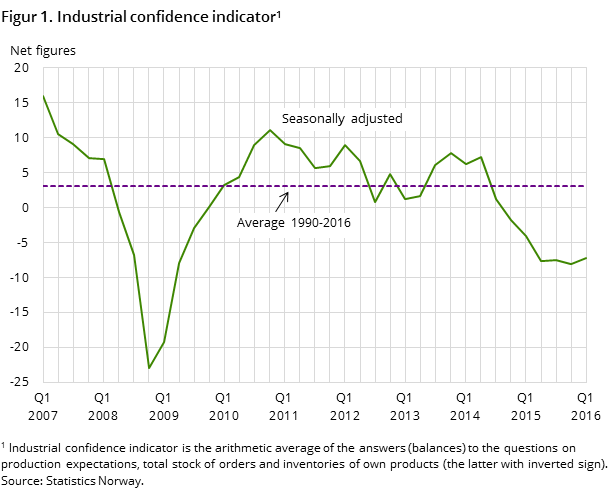
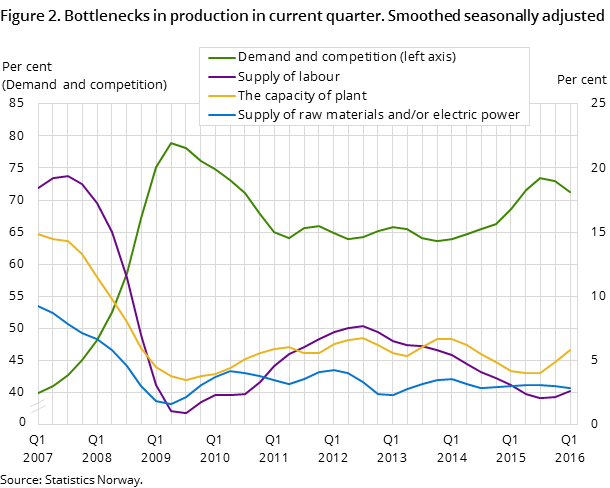
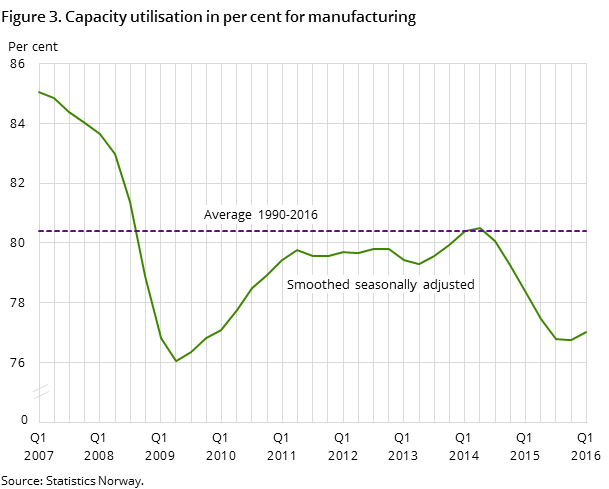
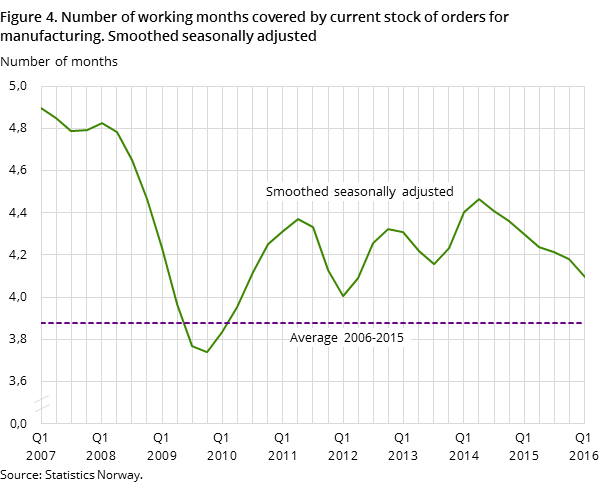
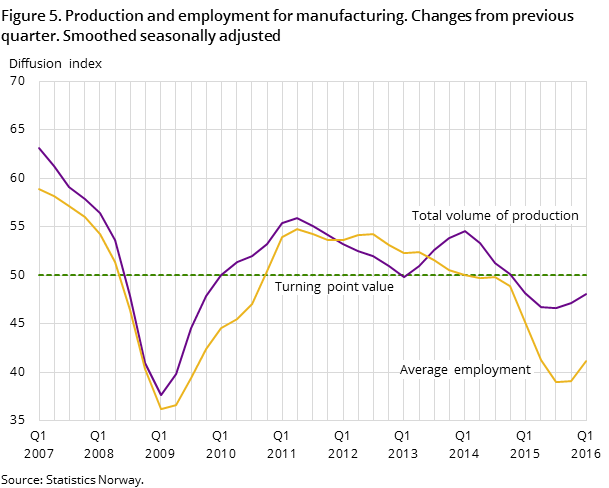
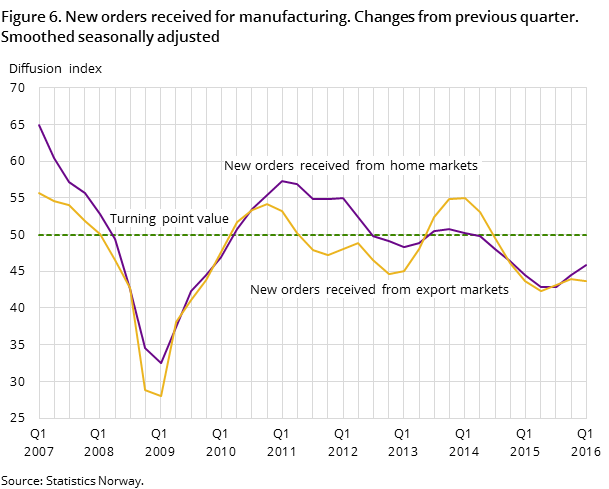
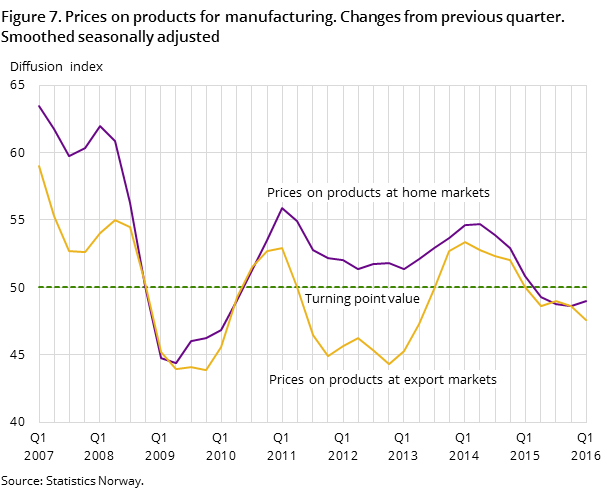
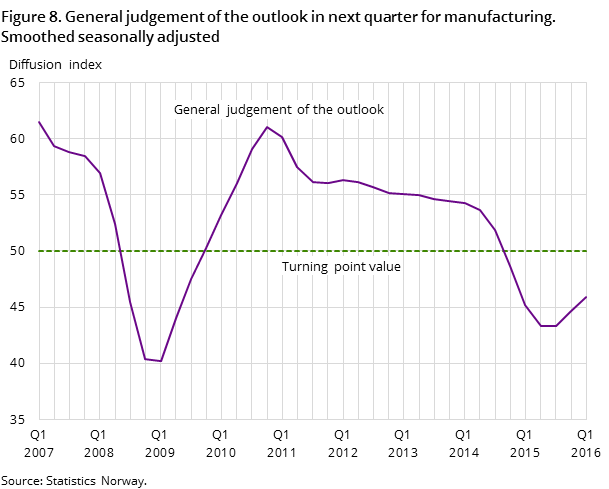
The business tendency survey for the first quarter of 2016 shows a downturn in total production compared with the fourth quarter of 2015. It is particularly manufacturers of capital goods that are experiencing a decline in industrial production, thus pulling down manufacturing as a whole. The low activity among suppliers to the oil and gas sector continues to contribute to the decline, such as:
- Machinery and equipment
- Building of ships,boats and oil platforms
- Repair and installation of machinery
The rate of the decline remains somewhat unchanged in these industries, which means that the number of industry leaders that are negative to the development in production is about the same or slightly smaller than in the previous quarter. Producers of intermediate goods reported roughly the same production level overall as in the previous quarter. There is an increase in industries such as basic metals and wood and wood products, while manufacturers of basic chemical have reduced production. At the same time, increased production can be seen within consumer goods, especially for manufacturers of food.
The overall employment declined in the first quarter of 2016. The decline comes from producers in all three main industrial groupings. The fall is most significant among producers of capital goods that are particularly connected to the oil and gas sector. However, the rate of the overall decline in employment is not growing compared with the previous quarter.
Reduced demand and lower prices
There was a decline in the total stock of orders in the first quarter. New orders from both the domestic and export markets saw a fall from the pervious quarter. The fall in orders from manufacturers of capital goods accounted for the main decline in manufacturing, and this drop particularly affects the suppliers to the oil and gas sector. Producers of intermediate goods also had a decline in new orders, mainly from the export market. During the same period, they also had a reduction in the stock of orders. Producers of consumer goods experienced increased orders from both the domestic and export market, and an increased stock of orders.
Regarding prices, there was a decline in both the domestic and export markets for manufacturers of capital goods. For intermediate goods, prices in the domestic market went down slightly, while the export price was roughly the same as the previous quarter.
The traditional export-oriented industry, non-ferrous metals had falling prices for four consecutive quarters, but in this quarter fewer are reporting a further drop in prices than in the previous quarter. For consumer goods there was a notable increase in prices in both markets, especially in food products.
Different expectations for the second quarter of 2016
The general outlook for the second quarter of 2016 is negative, which has been the case for six consecutive quarters. Business leaders report that investment plans are adjusted downward, while the supply of new orders and the stock of orders are expected to fall. There is also a clear expectation of a further drop in employment. Producers of capital goods are the most sceptical in relation to the next quarter, but producers of intermediate goods are also pessimistic. Manufacturers of consumer goods have a more optimistic view of the coming quarter, expecting higher production, increased supply of new orders and further improvement in prices.
The industrial confidence indicator in the first quarter was at -7.3 (seasonally-adjusted net figures), up from -8.1 in the previous quarter. This is below the historical average of 3.1. Values above zero indicate that total output will grow, while values below zero indicate that total output will fall. International comparisons of the industrial confidence indicator are available from Eurostat (EU), The Swedish National Institute of Economic Research and Statistics Denmark.
Marginal increase in capacity utilisation in manufacturing
Average capacity utilisation for Norwegian manufacturing had a marginal increase and was calculated to 77.0 per cent at the end of the first quarter of 2016, compared with 76.7 in the fourth quarter of 2015. This is below the historical average of 80.4 per cent. International comparisons of average capacity utilisation are available from Eurostat (EU).
The average number of working months covered by the current stock of orders was 4.1 in the first quarter of 2016. This is under the level in the previous quarter, but above the historical average of 3.9 months. The indicator on resource shortage is about the same level as the previous quarter. There is still little shortage of labour, good access to raw materials and electrical power, and few industry leaders are reporting full capacity utilisation.
Timeliness
The survey data was collected in the period from 10 March 2016 to 25 April 2016.
Assessment of Q1 2016 and the short-term outlook¹
1 An overall evaluation of the present situation and expected short-term developments. 2 Very good: ++, Good: +, Stable: ~, Poor: -, Very poor: --, Good, but with certain negative indications: +(-), A situation where the + and - factors even out: +/-, Poor, but with certain positive indications: -(+) | |
| Industry | Evaluation 2 |
| Food, beverages and tobacco | + |
| Wood and wood products | + |
| Paper and paper products | + |
| Basic chemicals | - |
| Non-ferrous metals | +(-) |
| Fabricated metal products | - |
| Computer and electrical equipment | - |
| Machinery and equipment | -- |
| Ships, boats and oil platforms | -- |
| Repair, installation of machinery | - |
Additional information
The statistics provide current data on the business cycle for manufacturing, mining and quarrying by collecting business leaders’ assessments of the economic situation and the short term outlook.
Contact
-
Edvard Andreassen
E-mail: edvard.andreassen@ssb.no
tel.: (+47) 40 90 23 32
-
Ståle Mæland
E-mail: stale.maeland@ssb.no
tel.: (+47) 95 05 98 88
